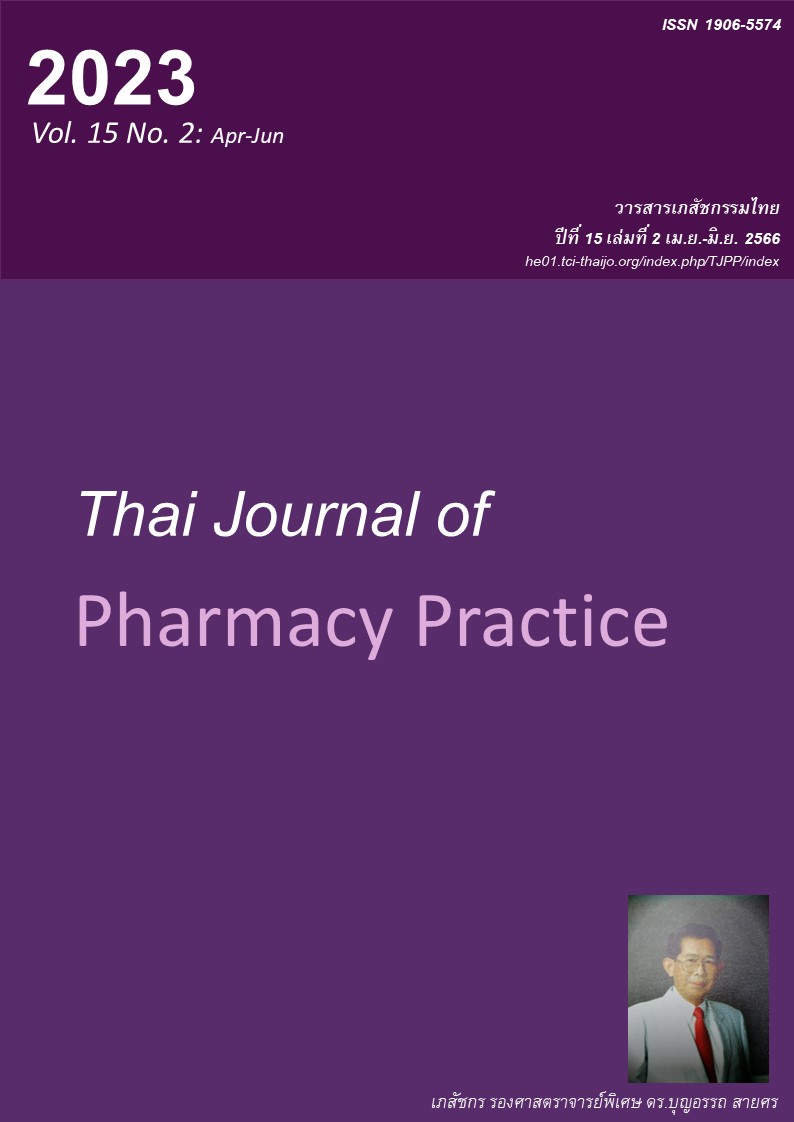ผลลัพธ์การให้ยาป้องกันทุติยภูมิในผู้ป่วยโรคหัวใจขาดเลือดเฉียบพลัน ชนิดที่ไม่มีคลื่นไฟฟ้าหัวใจส่วนเอสทียกสูง ณ เวลา 1 ปี หลังจำหน่ายจากโรงพยาบาล
Main Article Content
บทคัดย่อ
วัตถุประสงค์: เพื่อประเมินผลลัพธ์การให้ยาป้องกันทุติยภูมิตามแนวทางการรักษาในผู้ป่วยโรคหัวใจขาดเลือดเฉียบพลันชนิด NSTE-ACS (non–ST-elevation acute coronary syndrome) หลังจำหน่ายจากโรงพยาบาลเป็นเวลา 1 ปี วิธีการ: การวิจัยนี้เป็นการศึกษาเชิงวิเคราะห์แบบเก็บข้อมูลย้อนหลังและติดตามไปข้างหน้าจากเวชระเบียนในฐานข้อมูลอิเล็กทรอนิกส์ของโรงพยาบาล 2 แห่ง ระหว่างเดือนตุลาคม พ.ศ. 2558 – กันยายน พ.ศ. 2561 ในผู้ป่วย NSTE-ACS ที่มีอายุตั้งแต่ 18 ปีขึ้นไป เข้ารับการรักษาตัวในโรงพยาบาล และจำหน่ายด้วยสถานะรอดชีวิต เก็บข้อมูลการได้รับ ยาป้องกันทุติยภูมิทั้ง 4 กลุ่ม ได้แก่ ยากลุ่ม dual anti-platelets ยากลุ่ม beta-blockers (BBs) ยากลุ่ม angiotensin-converting enzyme inhibitors (ACEIs) หรือยากลุ่ม angiotensin receptor blockers (ARBs) และยากลุ่ม statins และการเกิดเหตุการณ์ไม่พึงประสงค์ (adverse events; AEs) หลังจำหน่าย ณ ติดตามจนครบ 1 ปี ศึกษาวิเคราะห์อัตราการเกิด AEs ด้วยสถิติ Cox-proportional hazard regression analysis ที่ปรับด้วย propensity score ผลการวิจัย: จากผู้ป่วยจำนวน 334 รายในการศึกษา พบ 44 รายได้รับยาป้องกันทุติยภูมิครบทั้ง 4 กลุ่ม คิดเป็นร้อยละ 13.17 และผู้ป่วยจำนวน 290 ราย ได้รับ ยาป้องกันทุติยภูมิไม่ครบ 4 กลุ่ม คิดเป็นร้อยละ 86.83 อัตราการเกิด AEs ณ เวลา 1 ปี ในกลุ่มผู้ป่วยที่ได้รับยาป้องกันทุติยภูมิครบทั้ง 4 กลุ่ม ลดลงร้อยละ 6 เมื่อเปรียบเทียบกับกลุ่มผู้ป่วยที่ได้รับยาไม่ครบ 4 กลุ่ม (adjusted HR 0.94, 95%CI 0.56-1.57; P=0.814) อัตราการได้รับยาป้องกันทุติยภูมิทั้ง 4 กลุ่ม เพิ่มขึ้นอย่างมีนัยสำคัญ ณ เวลาติดตามที่ 6 และ 12 เดือนเมื่อเปรียบเทียบ ณ เวลาที่จำหน่ายผู้ป่วย (ร้อยละ 13.17 กับ ร้อยละ 27.98; P<0.001, ร้อยละ 13.17 กับ ร้อยละ 27.49; P<0.001 ตามลำดับ) ปัจจัยด้านโรคร่วม ได้แก่ โรคหัวใจล้มเหลว (adjusted OR 0.30, 95%CI 0.12-0.77; P=0.012) และโรคไตวายเรื้อรัง (adjusted OR 0.25, 95%CI 0.09-0.67; P=0.006) สัมพันธ์กับการได้รับยาป้องกันทุติยภูมิทั้ง 4 กลุ่มที่ลดลงอย่างมีนัยสำคัญทางสถิติ ปัจจัยด้านสถานพยาบาลที่ผู้ป่วยเข้ารับการรักษา สัมพันธ์กับการได้รับยาป้องกันทุติยภูมิทั้ง 4 กลุ่มเพิ่มขึ้นอย่างมีนัยสำคัญทางสถิติ (adjusted OR 7.82, 95%CI 2.04-29.4; P=0.003) สรุป: ผู้ป่วย NSTE-ACS ได้รับยาป้องกันทุติยภูมิทั้ง 4 กลุ่มเพิ่มขึ้นอย่างมีนัยสำคัญทางสถิติ ณ เวลาที่ติดตาม 1 ปี ปัจจัยด้านสถานพยาบาลสัมพันธ์กับการได้รับยาป้องกันทุติยภูมิทั้ง 4 กลุ่มเพิ่มขึ้น โรคหัวใจล้มเหลวและโรคไตวายเรื้อรังสัมพันธ์กับการได้รับยาป้องกันทุติยภูมิทั้ง 4 กลุ่มลดลงอย่างมีนัยสำคัญ
Article Details

อนุญาตภายใต้เงื่อนไข Creative Commons Attribution-NonCommercial-NoDerivatives 4.0 International License.
ผลการวิจัยและความคิดเห็นที่ปรากฏในบทความถือเป็นความคิดเห็นและอยู่ในความรับผิดชอบของผู้นิพนธ์ มิใช่ความเห็นหรือความรับผิดชอบของกองบรรณาธิการ หรือคณะเภสัชศาสตร์ มหาวิทยาลัยสงขลานครินทร์ ทั้งนี้ไม่รวมความผิดพลาดอันเกิดจากการพิมพ์ บทความที่ได้รับการเผยแพร่โดยวารสารเภสัชกรรมไทยถือเป็นสิทธิ์ของวารสารฯ
เอกสารอ้างอิง
Policy and Strategy Office of the Permanent Secretary Ministry of Public Health. Public health statistics [online]. [cited Jun 18, 2018]. Available from: www.thaincd.com/2016/mission/documents.ph p?tid=32&gid=1-020
Tunstall PH, Kuulasmaa K, Mähönen M, Tolonen H, Ruokokoski E AP. Contribution of trends in survival and coronary-event rates to changes in coronary heart disease mortality: 10-year results from 37 WHO MONICA project populations. Monitoring trends and determinants in cardiovascular disease. Lancet 1999; 353: 1547-57.
Rogers WJ, Frederick PD, Stoehr E, Canto JG, Ornato JP GC. Trends in presenting characteristics and hospital mortality among patients with ST elevation and non-ST elevation myocardial infarction in the National Registry of Myocardial Infarction from 1990 to 2006. Am Hear J. 2008; 156: 1026-34.
Fox KAA, Dabbous OH, Goldberg RJ, et al. Prediction of risk of death and myocardial infarction in the six months after presentation with acute coronary syndrome: prospective multinational observational study (GRACE). BMJ 2006; 333: 1091.
Srimahachota S, Kanjanavanit R, Boonyaratavej S, et al. Thai registry in acute coronary syndrome registry (TRACS) Group: Lower in-hospital but still high mortality at one-year. J Med assoc Thai 2012; 95: 508-18.
Terkelsen CJ, Lassen JF, Nørgaard BL, et al. Mortality rates in patients with ST-elevation vs. non-ST-elevation acute myocardial infarction: Observa- tions from an unselected cohort. Eur Heart J. 2005; 26: 18-26.
Braunwald E. ACC/AHA Guideline Update for the Management of patients with unstable angina and non-st-segment elevation myocardial infarction--2002: Summary article: A report of the American College of Cardiology/American Heart Association Task Force on Practice Guidel. Circulation. 2002; 106: 1893-900.
Vogel B , Hahne S, Kozanli I, Kalla K, Jarai R, Freynhofer M, Smetana P, Nürnberg M, Geppert A, Unger
G HK. Influence of updated guidelines on short- and long-term mortality in patients with non-ST-segment elevation acute coronary syndrome (NSTE-ACS). Int J Cardiol. 2012; 159: 198-204.
Hengrassami K. Situation of ST elevation myocar- dial infarction in Thailand in standardand referral system of acute myocardial infarction 2554. Bangkok: Sukumvit Printing; 2011.
Amsterdam EA, Wenger NK, Brindis RG, et al. 2014 AHA/ACC guideline for the management of patients with non-st-elevation acute coronary syndromes: A report of the American College of Cardiology/ American Heart Association Task Force on Practice Guidelines. Circulation. 2014; 130: e344-e426.
Roffi M, Patrono C, Collet J-P, et al. 2015 ESC Guidelines for the management of acute coronary syndromes in patients presenting without persistent ST-segment elevation. Eur Heart J. 2016; 37: 267-315.
Hengrassami K. Standardand referral system of acute myocardial infarction 2017. Nonthaburi: Central Chest Institute, Ministry of Public Health; 2017.
Ariyapim N, Suksomboon N, Wongvipaporn C, Chaikledkaew U. The rationale to guideline of treatment for secondary prevention in patients with acute coronary syndromes. Thai Journal of Hospital Pharmacy 2007; 17: 68-76.
Kasemsup P, Kongsri S, Cheawchanwattana A, Limwattananon C. Drug treatments and outcomes of acute coronary syndrome patients in secondary-care hospital. Isan Journal of Pharmaceutical Sciences 2011; 7: 29-39
Byeon HJ, Yang Y, Choi EJ. Optimal medical therapy for secondary prevention after an acute coronary syndrome: 18-month follow-up results at a tertiary teaching hospital in South Korea. Ther Clin Risk Manag 2016; 12: 167–75.
Alan JB, Andrew TY, Raymond TY, Cindy HL, et al. Optimal medical therapy for non–ST-segment–elevation acute coronary syndromes : Exploring why physicians do not prescribe evidence-based treatment and why patients discontinue medications after discharge. Circ Cardiovasc Qual Outcomes 2010; 3: 530-7.
Jackevicius CA, Li P, Tu J V. Prevalence, predictors, and outcomes of primary nonadherence after acute myocardial infarction. Circulation. 2008; 117: 1028-36.
Nguyen T, Le KK, Cao HTK, et al. Association between in-hospital guideline adherence and postdischarge major adverse outcomes of patients with acute coronary syndrome in Vietnam: a prospective cohort study. BMJ Open 2017; 7: e017008. doi: 10.1136/bmjopen-2017-017008
Lee HY, Cooke CE, Robertson TA. Use of secondary prevention drug therapy in patients with acute coronary syndrome after hospital discharge. J Manag Care Pharm. 2008; 14: 271-80.


